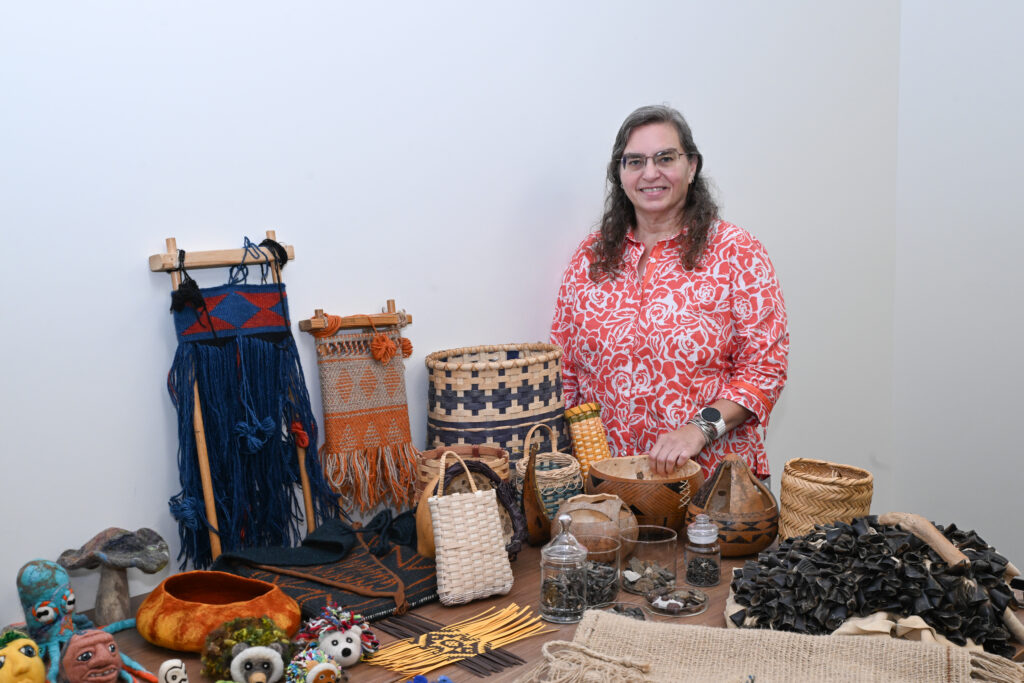
Story: Lisa Sollie | Photo/Video: Cody Ingram
Monica Newman Moore doesn’t just study history, she lives it. As a living historian, Moore immerses herself in the past, adopting the dress, customs, and daily activities of earlier times. Now, her passion and expertise are being channeled into her new role as office and cultural programs coordinator in the Division of Lifelong Learning and Economic & Workforce Development at the University of West Alabama.
Based in the newly renovated Black Belt Regional Development Center and serving the Black Belt Museum, Moore is crafting programs for adults and children that connect people with history and the cultural arts—one story, one artifact, one hands-on demonstration at a time.
“Lifelong learning requires having access to learning experiences that foster both connection and personal fulfillment,” says Dr. Andrea Mayfield, dean of the Division. “Monica’s role opens the door to community programs that complement our museum exhibits and allow participants to engage with the history, traditions, and cultures that link us to one another, to our past and present.”
Moore’s dedication to preserving and sharing history is rooted in her own family legacy. Her stepfather, the late Dr. John Hall, was appointed by UWA in 2006 to establish and lead the Black Belt Museum in Livingston. Her mother, Rosa Newman Hall, spent many years working at the Alabama Museum of Natural History and Moundville Archaeological Park at the University of Alabama.
As a child, Moore often accompanied her mother as she led hands-on natural history and cultural workshops. By high school, she was regular at the Moundville Native American Festival, which her mother helped found in 1988.
“I started out with pottery, sitting with the potter during the festival,” Moore recalls. “Another year, I spent time with a woman demonstrating beading. Each festival I attended, I learned a new skill.”
One night around a campfire at a living history camp, Moore saw a girl weaving a small woven bag. That simple moment lit a spark that would become a lifelong passion.
“It looked like what we might call finger weaving—rows and columns of yarn—and I was confident I could go home and replicate it. But I failed big time,” she laughs.
She didn’t give up. At the next year’s event, Moore returned and learned the technique properly. This ancient method of interlacing strands to create fabric, bags, and other woven items—known as twining—has deep roots in many Indigenous cultures, including those once thrived in Alabama and the Black Belt region.
Now more than 30 years later, Moore is still twining, and teaching others to do the same. Her book, Twined Bags: An Historic Finger-weaving Craft of the Native Americans, was published by Livingston Press.
In her twine bag workshops, Moore shares the historical context of the craft while guiding participants to create their own five-by-five-inch bag with a flap, a hands-on experience that brings history to life.
She also weaves stories into her twining demonstrations. One favorite comes from Bernard Romans, a Dutch American cartographer and explorer who passed through the Southeast in 1772, observing a ceremonial dance featuring what he later discovered were deer-toe leggings.
“He described nine women pulling on what looked like stockings, adorned with something that hung like bells, but sounding more like castanets,” Moore recounts. “The woman hosting him that evening was one of the dancers. Upon closer examination, Romans found her leggings had 493 deer toes sewn onto them—two toes per hoof.”
These vivid, sensory stories help students and visitors connect with history in powerful ways, and fuel Moore’s work far beyond Livingston.
In July 2026, Moore will return to teach twining at the John C. Campbell Folk School in Brasstown, North Carolina, where she has been an instructor since 2008. Founded in 1925, the school is the oldest and largest institution of its kind in the U.S., offering immersive courses in traditional arts and crafts.
Mayfield emphasizes that community cultural and creative arts programs are just one part of Division’s broader mission.
“The recent restructuring of the Division has allowed us to further strengthen community connections, expand partnerships and extend University outreach,” she says. We’re also offering short term certification programs and unique community learning experiences that build resilient communities, cultivate a love for lifelong learning, and drive economic development for a better quality of life.”
Back in Livingston, Moore is expanding public engagement through a growing slate of programming at the Black Belt Museum and across the region. She leads demonstrations in the Museum’s program room and in a larger training space on the second floor of the Development Center, tailoring content for school groups, senior citizens, and local organizations.
“I recently did a needle felting demonstration with the local Daughters of the American Revolution chapter, and another with the Livingston Book Club in September,” Moore says. “Working with groups like these is a great way to get out in the community.”
From heritage festivals like the Sucarnochee Folklife Festival in Livingston, held annually for over 20 years—to Frontier Days in Wetumka, Alabama, each November, classroom visits, and artisan workshops, Moore views every event as an opportunity to do more than just teach.
“I’m a hands-on learner,” she explains. “These demonstrations let me show others how to take natural materials, just like people did hundreds of years ago, and transform them into something useful like a bag or basket, or something beautiful and fun, like a dream catcher.”
Her stepfather’s words still guide her approach.
He used to say, ‘If you can see it, touch it, sometimes even smell it, experience it – you’re going to remember it.’ That’s still true today.”
For more information contact Monica Newman Moore at mmoore@uwa.edu or call (205) 652-3828.